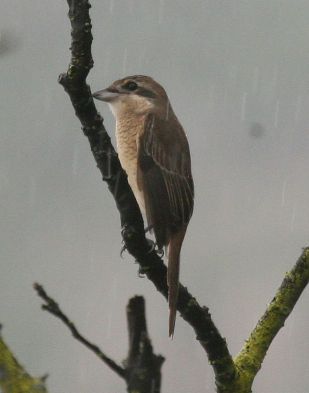A very wet and wild week in south Hong Kong. The ferry didn't run for one week because of winds and rough seas, so I wasn't able to see if any seabirds were blown in last weekend.
Today, an early Brown Shrike, enjoying the rain.



Also a Common Kingfisher, the White-throated Kingfisher, 2 Great Tits and a White Wagtail.
This week completes a full year of detailed recording for me which started on 17th August 2006 and finished today, 16th August 2007. I kept records on 153 days and saw 222 species over this period (22 residents, 150 other land birds, 22 waders and 28 sea birds). At least another 6 species were seen by others.
This graph shows the number of non-resident land bird species seen each day visited throughout the year (in pink) and the average HK daily temperature that day (in blue)

Two features are typical for Hong Kong
1. More species are seen in spring than in autumn. This characteristic of Hong Kong birds was first noted as early as 1913 by Vaughan and Jones in their 1913 HK Bird List.
2. The number of species increases when there is a significant fall in temperature. This occurs throughout the year, although the reasons are different in each season. Temperature is not usually the cause of the increase, the real cause is wind direction and strength.
In autumn – a surge of northerly winds brings migrants flying across China from the north east to the south west down into Hong Kong. See 11th and 12th September after 3 days of strong N winds (remember the Tiger Shrikes?)
In winter – a surge of northerly winds and cold weather brings wintering species from further north down into Hong Kong. Temperature may be a motivating factor at this time. See 9th January.
In spring – north-easterly winds after a cold front bring migrants flying north from the Philippines into Hong Kong. See 3rd April. This is the only time of the year when Philippine wintering species such as Ferruginous Flycatcher, Japanese Yellow Bunting can be seen in Hong Kong and mostly explains why species numbers are greater in spring than autumn.
For a detailed analysis of Weather and Bird Migration in Hong Kong, see the ground-breaking paper by Lam and Williams in the 1993 HKBWS Annual Report.
I will only do two days a week on Po Toi for the next few weeks as my wife is expecting a baby in September. But if all goes well, I expect to be back in full action soon.
[
Last edited by wgeoff at 18/08/2010 13:45 ]


